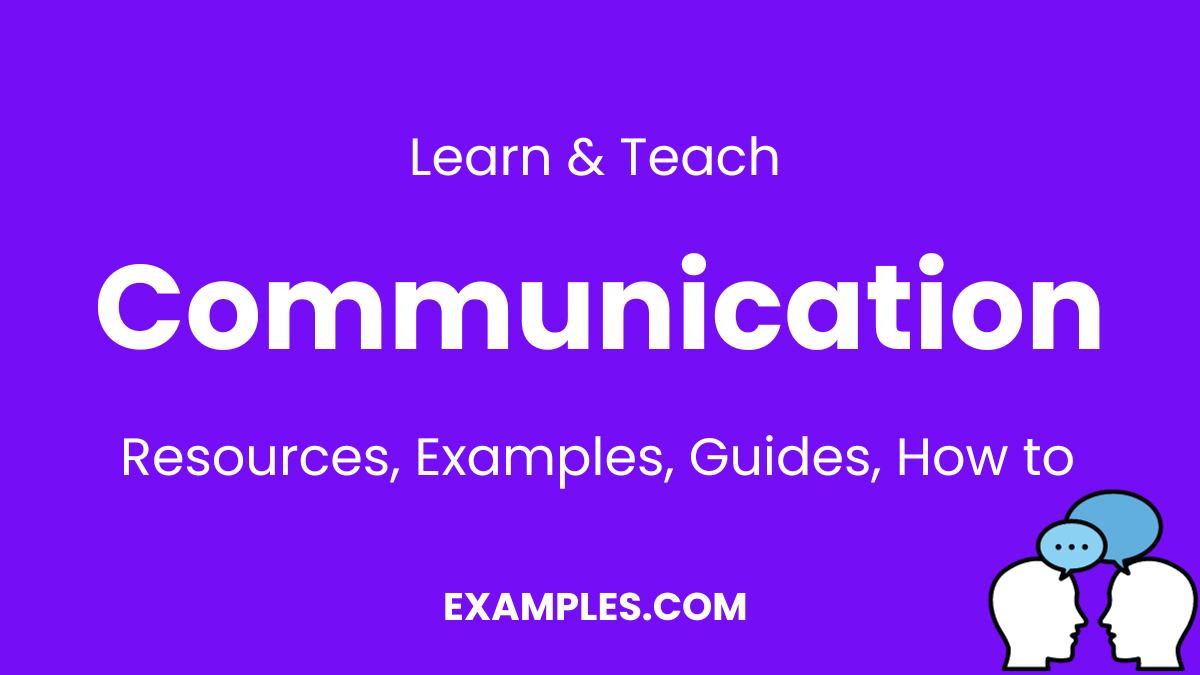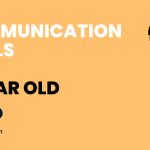Unlock the fascinating world of a 4-year-old’s communication skills with our comprehensive guide. In this enriching exploration, discover the essential milestones, effective strategies, and real-life communication examples tailored to your child’s developmental journey. Nurturing their verbal expression, nonverbal cues, and interpersonal connections has never been more engaging. Prepare to embark on a transformative experience as we delve into the intricacies of fostering Communication Skills of a 4-year-old. Let’s embark on this enlightening journey together.
What is Communication Skills of a 4 Year Old?
Communication skills in a 4-year-old refer to their ability to express thoughts, feelings, and needs effectively. At this age, children develop verbal and nonverbal communication, building the foundation for social interactions. Through words, gestures, and interactions, they convey ideas and connect with others. This pivotal stage lays the groundwork for a lifetime of effective communication. In simple terms, it’s the delightful journey of a 4-year-old expressing themselves and understanding the world around them.
30 Communication Skills of a 4-Year-Old Examples
Discover the enchanting world of a 4-year-old’s communication skills through these vivid examples. Each instance showcases the blossoming abilities in language, expression, and social interaction, contributing to a well-rounded development.
- Expressive Vocabulary: The child adeptly uses words like “brilliant” and “fantastic” to convey emotions.
- Articulate Storytelling: Narrating imaginative tales with a blend of vivid descriptions and animated gestures.
- Active Listening: Demonstrating attentiveness by responding appropriately to spoken words.
- Sharing Emotions: Expressing joy, frustration, or excitement through both words and facial expressions.
- Turn-Taking in Conversations: Engaging in dialogue by patiently waiting for their turn to speak.
- Polite Expressions: Saying “please” and “thank you” to convey manners and gratitude.
- Following Instructions: Demonstrating the ability to follow directions accurately.
- Asking Questions: Inquisitive minds asking questions like “Why is the sky blue?”
- Imitating Sounds: Mimicking various sounds and tones, showcasing auditory perception.
- Role-Playing: Engaging in imaginative scenarios, taking on different roles during play.
- Naming Colors and Shapes: Displaying knowledge by correctly identifying colors and shapes.
- Expressing Preferences: Communicating likes and dislikes, asserting personal choices.
- Use of Gestures: Complementing speech with gestures to enhance communication.
- Counting and Numeracy: Demonstrating early counting skills and numerical understanding.
- Recognizing Friends: Identifying and naming friends, fostering social connections.
- Problem-Solving Language: Verbally expressing solutions to simple problems.
- Expressing Empathy: Comforting others with words when they are upset or sad.
- Making Requests: Politely making requests such as asking for a snack or a toy.
- Story Recollection: Retelling events or stories in a coherent and sequential manner.
- Initiating Greetings: Taking the initiative to greet others with a cheerful “hello” or “hi.”
- Using Pronouns: Mastering the use of pronouns like “I,” “you,” and “we” for effective communication.
- Expressing Curiosity: Demonstrating curiosity about the world by asking “How” and “Why” questions.
- Making Connections: Connecting past experiences with present conversations.
- Reciting Rhymes: Enjoying and reciting nursery rhymes with rhythm and expression.
- Expressing Gratitude: Saying “thank you” for gestures of kindness, fostering gratitude.
- Naming Body Parts: Identifying and naming different body parts.
- Using Prepositions: Grasping spatial relationships by using words like “under,” “over,” and “behind.”
- Conveying Excitement: Expressing enthusiasm through words and animated gestures.
- Understanding Humor: Demonstrating an emerging sense of humor through jokes and laughter.
- Recalling Events: Sharing detailed accounts of recent experiences with clarity.
What are the Social Communication Milestones for a 4 Year Old?
In the realm of a 4-year-old’s development, social communication milestones play a crucial role. Understanding these benchmarks aids in nurturing healthy interpersonal connections. At this age, children begin to engage in more complex interactions, demonstrating progress in their communication abilities. Here’s a comprehensive guide to the social communication milestones for a 4-year-old:
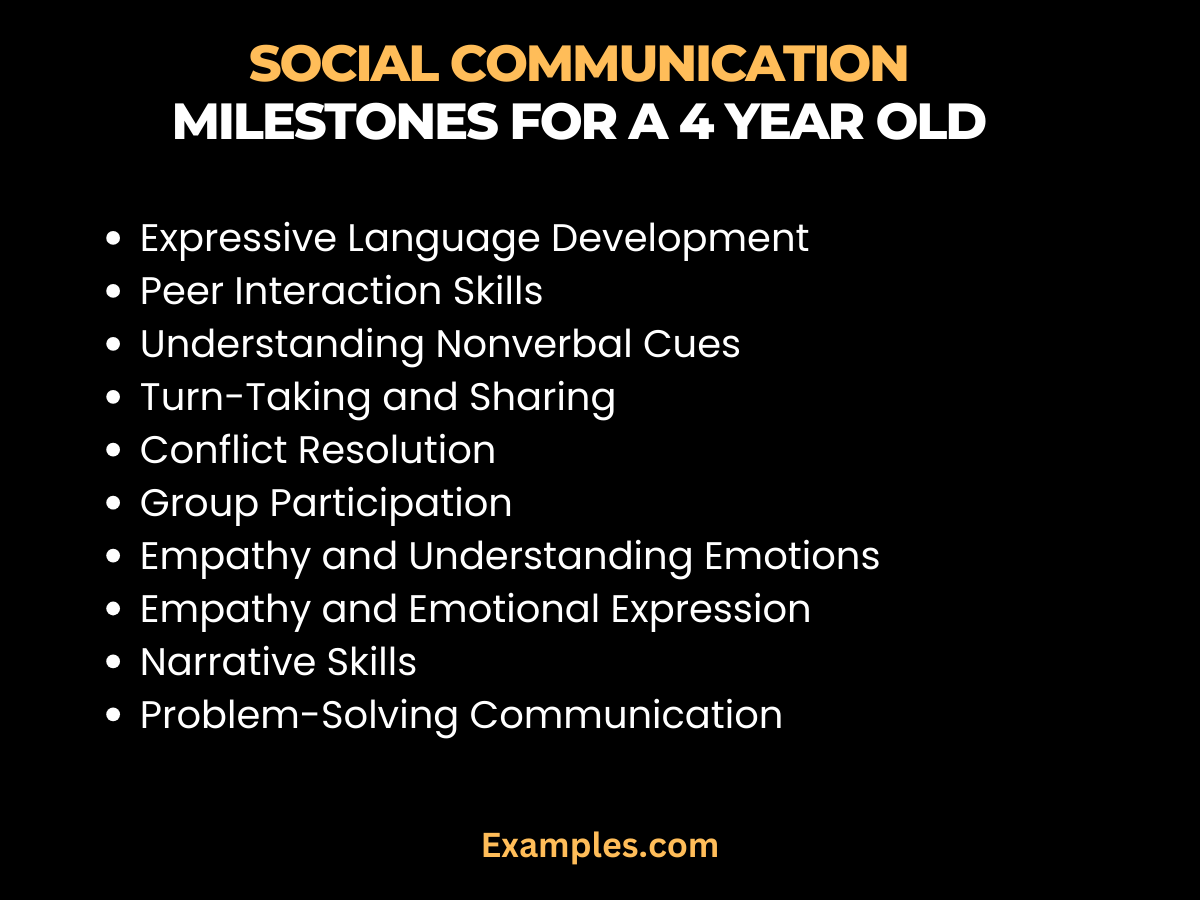
- Expressive Language Development: Witness the blossoming of expressive language as 4-year-olds articulate thoughts and feelings, Explore examples of how children use words to convey emotions and desires.
- Peer Interaction Skills: Delve into the world of peer interactions, observing how 4-year-olds initiate and sustain conversations, Uncover tips on fostering positive social connections among children.
- Understanding Nonverbal Cues: Examine the ability of 4-year-olds to interpret nonverbal cues such as facial expressions and body language, Learn how to support their comprehension of subtle communication signals.
- Turn-Taking and Sharing: Explore the development of turn-taking and sharing behaviors in social settings, Discover practical strategies for encouraging cooperative play and communication.
- Conflict Resolution:Understand how 4-year-olds navigate conflicts and express themselves assertively, Gain insights into teaching effective conflict resolution skills.
- Group Participation: Investigate the emerging skill of participating in group activities and conversations,Find examples illustrating how children contribute to group dynamics.
- Empathy and Understanding Emotions: Explore the growth of empathy as 4-year-olds begin to understand and respond to others’ emotions,Discover activities that nurture emotional intelligence in social interactions.
- Empathy and Emotional Expression: Delight in the emergence of empathy and the expression of emotions through words and actions.
- Narrative Skills: Witness the development of storytelling abilities, a crucial aspect of effective communication.
- Problem-Solving Communication: Examine how a 4-year-old tackles problem-solving through verbal communication, showcasing cognitive growth.
What are the Communication Skills of Preschoolers?
Preschoolers embark on a captivating journey of communication development, laying the groundwork for a lifetime of effective expression. At this pivotal stage, children hone both verbal and nonverbal communication skills.
Verbal Communication: Preschoolers begin articulating thoughts with expanding vocabulary, forming sentences, and expressing needs. Witness the magic as they engage in simple conversations, sharing their world with newfound words.
Nonverbal Communication: Beyond words, preschoolers master nonverbal cues—facial expressions, gestures, and body language. These subtle signals enhance their ability to convey emotions and understand others.
Social Communication Milestones: Explore the social milestones of preschoolers, observing their blossoming interactions with peers and adults. From sharing to taking turns, each achievement contributes to robust social communication.
Language Development Examples: Delve into real-life examples illustrating language development in 4-year-olds. Discover how storytelling, imaginative play, and daily interactions foster linguistic prowess.
Improving Communication Skills: Unlock practical tips for nurturing communication skills in preschoolers. From interactive games to fostering a language-rich environment, empower your child on their expressive journey.
Normal Communication Development: Understand the typical communication milestones for 4-year-olds. Gain insights into their evolving abilities, ensuring you provide the support needed for healthy communication growth.
Essential Communication Skills: Identify key communication skills expected at this age. Whether it’s effective listening, expressing emotions, or following instructions, learn what milestones mark this crucial stage.
Communicating with a 4-Year-Old: Navigate the unique dynamics of communicating with a 4-year-old. Discover effective strategies for fostering understanding, building trust, and encouraging open dialogue.
What is the Normal Communication Development of a 4 Year old?
Communication development in a 4-year-old is a dynamic and exciting process marked by significant milestones. At this age, children exhibit a rich vocabulary, forming sentences with increasing complexity. Their grasp of grammar strengthens, and they become adept at using pronouns and prepositions.
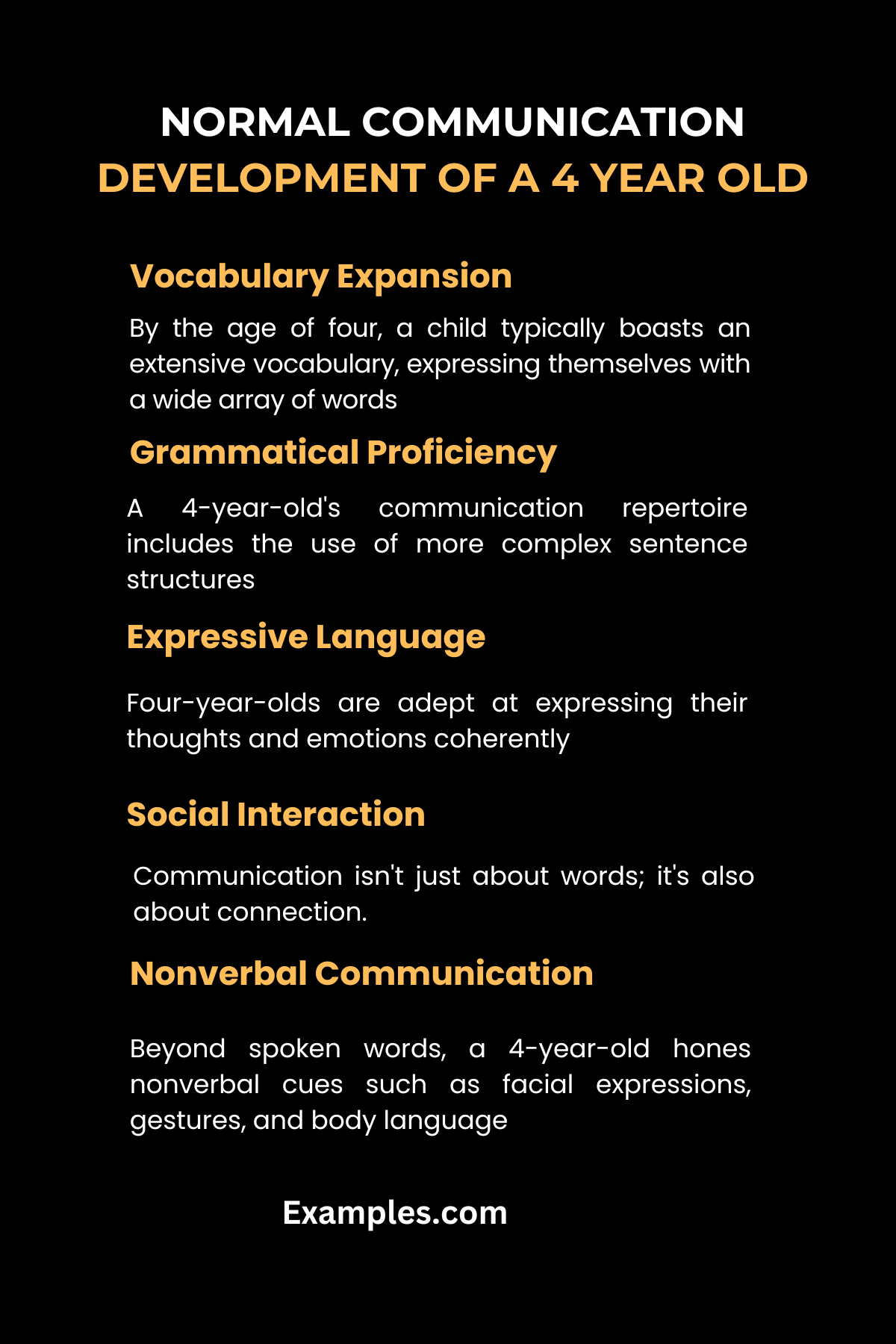
Vocabulary Expansion: By the age of four, a child typically boasts an extensive vocabulary, expressing themselves with a wide array of words. This stage marks the emergence of more nuanced language skills, enabling them to convey thoughts with greater precision.
Grammatical Proficiency: A 4-year-old’s communication repertoire includes the use of more complex sentence structures. They begin to master grammar rules, incorporating them into their speech naturally. Pronouns, prepositions, and verb tenses become integral components of their linguistic toolkit.
Expressive Language: Four-year-olds are adept at expressing their thoughts and emotions coherently. They can narrate simple stories, share experiences, and engage in imaginative play, showcasing a blossoming creativity in their communication.
Social Interaction: Communication isn’t just about words; it’s also about connection. Four-year-olds demonstrate improved social communication skills, engaging in conversations, understanding turn-taking, and expressing empathy towards others.
Nonverbal Communication: Beyond spoken words, a 4-year-old hones nonverbal cues such as facial expressions, gestures, and body language. This nuanced communication enhances their ability to convey emotions and comprehend the feelings of those around them.
What Communication Skills Should a 4 Year Old Have?
As your 4-year-old navigates the world, understanding the key communication skills they should possess is crucial. This comprehensive guide outlines the developmental milestones and abilities that contribute to effective communication at this age.
1. Verbal Expression: At four, children should exhibit a rich vocabulary, combining words into sentences. Explore activities and examples that enhance their ability to express thoughts and emotions verbally.
2. Nonverbal Communication: Delve into the nuances of nonverbal cues such as gestures, facial expressions, and body language. Discover how these elements play a vital role in a 4-year-old’s communication repertoire.
3. Social Interaction: Learn about the importance of social skills in communication. Explore activities that encourage positive interactions, sharing, and turn-taking, fostering healthy relationships.
4. Active Listening: Explore strategies to nurture active listening skills. Help your child understand the value of paying attention and responding thoughtfully in conversations.
5. Storytelling and Imagination: Encourage the development of imagination and storytelling. Discover how these skills contribute to language development and creativity.
6. Problem-solving Communication: Guide your 4-year-old in expressing themselves when facing challenges. Explore examples that promote effective problem-solving through communication.
7. Understanding Instructions: Examine how well your child comprehends and follows instructions. Gain insights into activities that enhance their ability to listen, process, and respond appropriately.
8. Empathy and Emotional Expression: Foster empathy and emotional intelligence. Learn how to navigate discussions about feelings and encourage your child to express and understand emotions.
How to Improve Communication Skills in a 4 Year Old?
Communication is a crucial skill that shapes a 4-year-old’s social and cognitive development. Here’s a comprehensive guide on how to foster and improve these vital skills:
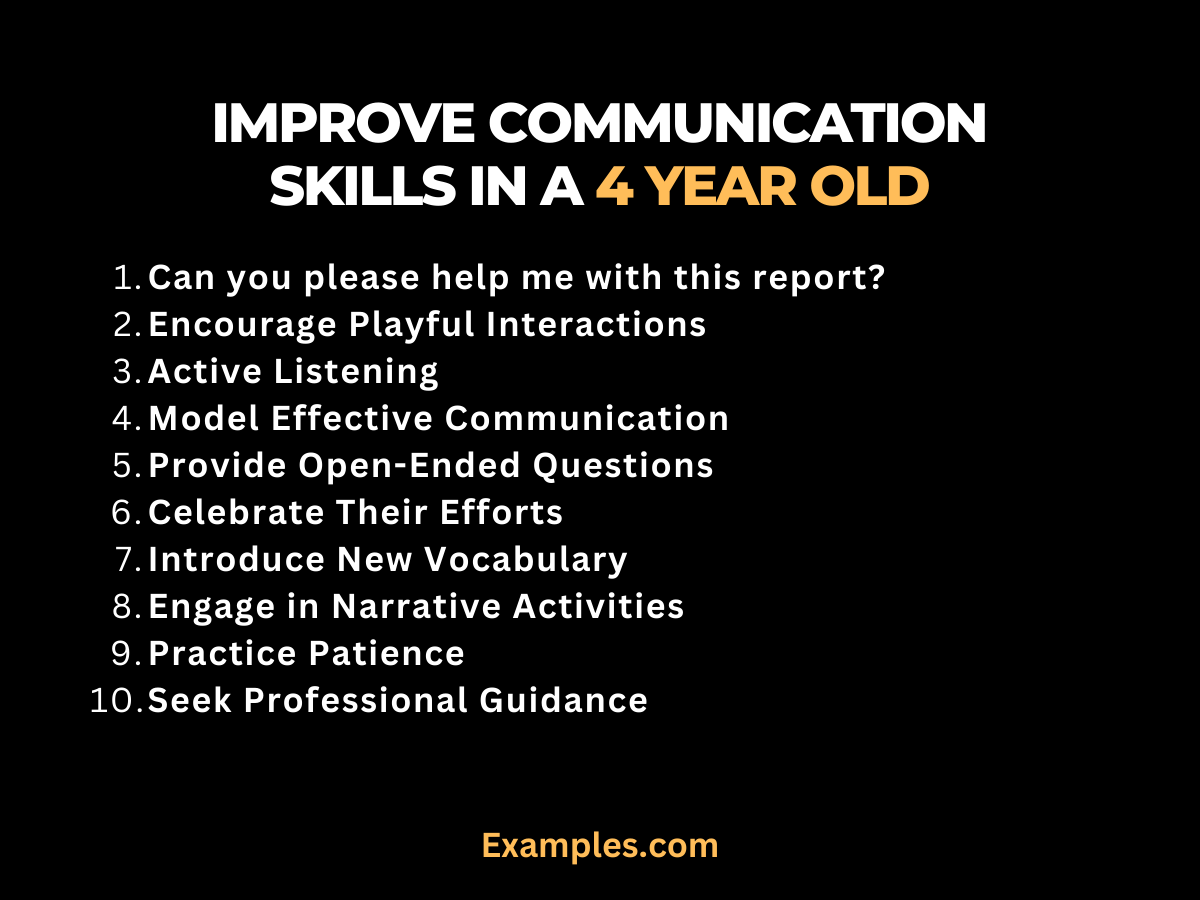
- Create a Language-Rich Environment: Surround your child with books, conversations, and engaging activities. This exposure nurtures vocabulary and encourages communication.
- Encourage Playful Interactions: Foster communication through play. Board games, storytelling, and imaginative play create opportunities for expression and language development.
- Active Listening: Demonstrate the importance of listening. Respond attentively to your child, validating their thoughts and encouraging them to articulate their ideas.
- Model Effective Communication: Children learn by example. Exhibit clear and concise communication, emphasizing proper language use and expression.
- Provide Open-Ended Questions: Encourage your child to express themselves by asking open-ended questions. This promotes critical thinking and expands their communication skills.
- Celebrate Their Efforts: Positive reinforcement is key. Acknowledge and celebrate your child’s attempts at communication, fostering confidence in their abilities.
- Introduce New Vocabulary: Expand their word bank by introducing new words daily. Use contextual examples to help them grasp the meaning and usage of words.
- Engage in Narrative Activities: Reading books and storytelling sessions enhance language skills. Encourage your child to share their thoughts and feelings about the stories.
- Practice Patience: Allow your child time to express themselves. Avoid completing their sentences, giving them the opportunity to develop their communication skills at their pace.
- Seek Professional Guidance: If you have concerns about your child’s communication development, consult with a pediatrician or speech therapist for expert advice.
In conclusion, fostering communication skills in a 4-year-old is a rewarding journey. This comprehensive guide has equipped you with practical examples, valuable insights, and actionable tips to nurture language development. Embrace the joys of witnessing your child express themselves confidently, setting the stage for a future filled with effective communication and meaningful connections. Start your exciting adventure in enhancing your 4-year-old’s communication skills today.


